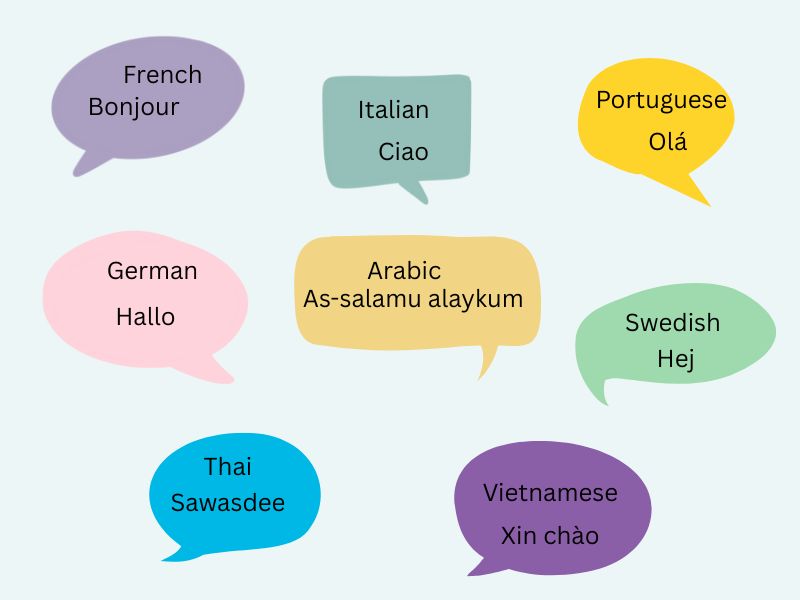Imagine walking into a room full of strangers across the globe and being able to greet each one in their own language. Feels magical, right? That’s the power of one simple word: hello.
Whether you’re traveling, watching international TV shows, or making friends online, knowing how to say hello in different languages opens up conversations and hearts. It’s the easiest way to show respect and spark smiles.
Plus, it’s fun! Think about how cool it is to walk into a French bakery and say “Bonjour” like a local or greet a Korean friend with “Annyeonghaseyo.” You don’t need to be fluent; just knowing how to say hello in different languages is enough to make someone feel seen.
In this guide, we’ll explore hello in different languages of the world. From French to Filipino, Japanese to Jewish, we’ve got your passport to global greetings right here.
How to Say Hello in Different Languages of the World
Want to say hello in different languages of the world? It’s easier and more fun than you think! From “Hola” in Mexico to “Sawasdee” in Thailand, each greeting carries a slice of culture. Sometimes it’s formal, sometimes it’s casual, but it always means, “I see you.”
A simple hello can spark a connection, show respect, and bring a smile. Whether it’s a bow, handshake, or cheek kiss, learning how to say hello across cultures is a great first step in making friends worldwide. Ready to explore? Let’s dive in!
Europe
If you’re headed to Europe or just dreaming about it, learning to say hello in different languages can make your trip extra special. People light up when you greet them in their own tongue, even if it’s just one word.
How to say hello in French
In France, saying “Bonjour” (pronounced bon-zhoor) is a must. It literally means “good day,” and it’s used everywhere from bakeries to the Metro. Want to sound more casual? Try “Salut.”
How to say hello in German
Germans greet each other with a simple “Hallo.” Easy, right? For more formal situations, you can say “Guten Tag,” which means “Good day.”
How to say hello in Italian
In Italy, you’ll hear “Ciao” a lot. It’s casual, fun, and works as both “hello” and “goodbye.” But for a more formal setting, go with “Salve.”
How to say hello in Spanish / Mexican
Whether you’re in Spain or Mexico, “Hola” (oh-lah) is your go-to greeting. It’s friendly, warm, and probably the most recognizable hello in the world.
How to say hello in Russian
In Russia, a casual “Privet” (pree-vyet) works with friends. But in formal situations, go with “Zdravstvuyte,” a tongue twister, but impressive if you get it right!
How to say hello in Dutch
The Dutch say “Hallo” too, much like in English. Want to sound more local? Try “Hoi” (pronounced like “hoy”) for something friendly and informal.
How to say hello in Greek
In Greece, say “Yasou” to one person and “Yasas” to more than one. Both mean hello and also serve as a general greeting like “cheers” in some cases.
How to say hello in Swedish
Swedes greet with a simple “Hej” (pronounced hay). Want to be extra friendly? You might hear “Hej hej!” kind of like saying “Hey there!”
How to say hello in Polish
In Poland, say “Cześć” (cheshch) to friends and “Dzień dobry” (jen DOH-brih) in more formal situations. Yes, it’s tricky to pronounce, but super appreciated when done right.

Asia
Asia is packed with beautiful languages and rich traditions. Whether you’re visiting Japan or chatting with a friend from India, knowing how to say hello in the local language makes a big difference. It shows you care, and people notice that right away.
How to say hello in Chinese
In Mandarin Chinese, say “Nǐ hǎo” (你好). It means “you’re good,” which is like asking “Are you well?” It’s a polite, all-purpose greeting, and it makes locals smile when you try it!
How to say hello in Japanese
In Japan, use “Konnichiwa” (こんにちは) during the day. It’s polite and safe to use anywhere. People bow a little when greeting, so if you do that too, even just a small nod you’ll fit right in.
How to say hello in Korean
Koreans take greetings seriously. Say “Annyeonghaseyo” (안녕하세요) to show respect. For friends or kids, “Annyeong” (안녕) is more casual. It’s like saying “Hi!” vs. “Hello, sir.”
How to say hello in Thai
In Thailand, say “Sawasdee” (สวัสดี). Men add “krub” at the end (Sawasdee krub), and women say “ka” (Sawasdee ka). Also, place your hands together in a prayer-like gesture, it’s called the wai.
How to say hello in Vietnamese
Vietnamese greetings depend on age, but the standard is “Xin chào.” It works in most situations, and locals will really appreciate your effort even if the tones aren’t perfect.
How to say hello in Indonesian
Indonesians greet each other with “Halo,” yes, just like in English. You might also hear “Selamat pagi” for “Good morning” or “Selamat siang” for “Good afternoon.” Simple and friendly!
How to say hello in India
India is full of languages, but “Namaste” (नमस्ते) is widely used and understood across the country. You say it with your hands together and a small bow. It means “I bow to the divine in you,” pretty deep for a hello!
How to say hello in Nepali
Nepal shares similar roots with India, so “Namaste” is used here too. The gesture and tone are the same, polite, respectful, and warm. You’ll often see it accompanied by a genuine smile.
How to say hello in Singapore
Singapore is multicultural, so greetings vary. English is common, but you’ll also hear “Nǐ hǎo” in Chinese areas, “Vanakkam” in Tamil communities, and “Salam” in Malay neighborhoods. A simple “Hello” works just fine everywhere!
Middle East
In the Middle East, greetings go beyond a simple hello. They often carry blessings, peace, and good wishes. If you’ve ever wondered how to say hello in Arabic, Hebrew, or Turkish, you’re about to find out, and it’s easier than you think!
How to say hello in Arabic
The most common greeting is “As-salamu alaykum” (السلام عليكم), which means “Peace be upon you.” The proper response is “Wa alaykumu as-salam.” It’s formal, respectful, and used across the Muslim world. For something more casual, you can also say “Marhaban.”
How to say hello in Jewish / Hebrew
In Israel, you’ll hear “Shalom” (שָׁלוֹם), which means “peace.” It’s both a greeting and a goodbye—just like “Aloha” in Hawaiian. Saying “Shalom” is a beautiful way to start any conversation because it’s peaceful by nature.
How to say hello in Turkish
Turkish people greet each other with “Merhaba.” (Sounds like “mehr-hah-bah.”) It’s polite, simple, and can be used in almost every situation. If you want to be extra friendly, pair it with a smile and a firm handshake.
The Americas & Island Nations
Whether you’re in Mexico, Hawaii, or the Philippines, one thing is for sure: people love to greet you with warmth. In many of these places, a smile and a friendly hello go a long way. But let’s make it even better by saying hello in their own language.
How to say hello in Mexican (Spanish)
In Mexico, the greeting is “Hola” (just like in Spain). It’s short, cheerful, and perfect for any situation. You can use it with friends, store owners, taxi drivers, or literally anyone. Want to sound extra friendly? Try “¡Hola, amigo!”
How to say hello in Filipino
In the Philippines, say “Kamusta” (pronounced kah-moos-tah). It comes from the Spanish “Cómo está,” but evolved into its own thing. Filipinos are super friendly, and just trying “Kamusta” can spark a long chat or even an invite to join lunch!
How to say hello in Portuguese (Brazil)
In Brazil and Portugal, “Olá” is your go-to. Brazilians are all about warm vibes, so don’t be surprised if your “Olá” turns into a hug or high-five.
How to say hello in Hawaiian
Hawaii greets you with “Aloha.” But this word is more than just a hello; it’s a whole spirit. Aloha means love, peace, and connection. When you say “Aloha,” you’re not just starting a conversation—you’re sharing good energy.
Conclusion
Learning how to say hello in different languages isn’t just about words; it’s about connection. Whether it’s Bonjour, Namaste, or Aloha, a simple greeting shows respect and warmth. It tells someone, “I see you. I care.” From Merhaba to Kamusta, these tiny words unlock big cultural doors.
So why not try one today? Say it in the mirror, to a friend, or your local barista. You never know what kind of connection it might spark.


Leave a Comment